The announcement on March 22, 2018, of the imposition of sanctions against China based on Section 301 of the U.S. Trade Act triggered the escalation of the U.S.-China trade dispute. In response to the tit-for-tat tariff hikes that are turning the dispute into a trade war, Chinese stock prices and the exchange rate of the yuan—the Chinese currency—have plunged, and the Chinese economy is starting to slow down. The impact of the trade dispute is expected not only to reduce Chinese exports to the United States but also to dampen investment and consumption in China. Under these circumstances, there are growing calls in China for the implementation of economic stimulus measures. However, the possibility that the government will meet such calls is expected to be small given the lesson China learned after the implementation of the four trillion-yuan economic package intended to stimulate domestic demand after the collapse of Lehman Brothers that triggered the global financial crisis: the economic package caused serious after-effects in the forms of the expansion of debt owed by local governments and excess production capacity at companies.
Impact of the U.S. trade sanctions
As part of its sanctions against China, the United States has imposed additional tariffs on some products imported from China and has been gradually expanding the scope of products subject to the sanctions. As the first tranche of the sanctions, on June 15, 2018, the United States announced a list of Chinese products subject to an additional tariff of 25%, which are worth a total of $50 billion. As the second tranche, on July 10, it announced a list of Chinese products subject to an additional tariff of 10%, which are worth a total of $200 billion. Regarding the first tranche of sanctions, the additional tariff was imposed on $34 billion worth of Chinese products on July 6. With respect to the remaining $16 billion worth of products, the additional tariff was imposed on August 23, after some items were deleted from the sanctions list. Regarding the first tranche of U.S. sanctions on $50 billion worth of Chinese products, China has announced plans to take a retaliatory measure against an equivalent worth of U.S. products, and regarding the second tranche, it has announced a plan to impose tariffs ranging from 5% to 25% on $60 billion worth of U.S. products.
The direct impact of the U.S. tariff hikes against Chinese products on the Chinese economy is expected to be limited. Let us calculate the impact of the tariff hikes based on the premise that China's price elasticity regarding exports to the United States is estimated at most at 1.5 (which means that a 1% price increase will lead to a 1.5% fall in export volume). If an additional tariff of 25% is applied to $50 billion worth of products, the value of Chinese exports to the United States is estimated to decline by $18.75 billion. If an additional tariff of 10% is applied to $200 billion worth of products, the value of exports is estimated to decline by $30 billion. The total estimated impact of these tariff hikes is an export decline of $48.75 billion. This figure is equivalent to only 0.4% of China's GDP in 2017 (approximately $12 trillion) (Table 1). Moreover, as China has been integrated into global supply chains, products exported from the country include a large amount of components imported from abroad. As a result, the value added in China (which is counted as part of China's GDP) is presumed to account for around only half of the export value (Note 1). In view of this point, even if exports decrease by a margin equivalent to 0.4% of GDP, the decline in the growth rate of GDP will be half of that rate, 0.2 percentage points.
| Value of U.S.-bound exports subject to the tariff hikes | Price elasticity | Tariff rate | Impact on exports | ||
|---|---|---|---|---|---|
| (a) | (b) | (c) | (a)×(b)×(c) | Ratio to GDP (Note) | |
| First tranche | $50 billion | 1.5 | 25% | $18.75 billion | 0.156% |
| Second tranche | $200 billion | 1.5 | 10% | $30.00 billion | 0.250% |
| Total | $250 billion | - | - | $48.75 billion | 0.406% |
| Note: The value of China's GDP in 2017 was approximately $12 trillion. According to Chinese statistics, the value of exports from China to the rest of the world was $2,263.2 billion, while the value of exports from China to the United States was $429.8 billion (according to U.S. statistics, the value of imports from China was $505.6 billion, while the value of exports to China was $130.4 billion, resulting in a U.S. trade deficit with China of $375.2 billion). Source: The figures concerning China were estimated by the author based on the CEIC Database (Original data from the General Administration of Customs of China), and the figures concerning the United States were estimated by the author based on data compiled by the U.S. Census Bureau and the IMF's World Economic Outlook Database. |
|||||
However, the impact of the U.S.-China trade dispute on the Chinese economy extends beyond exports. As symbolized by the plunges of stock prices and the yuan, concerns over the prospects for the economy are growing. In this situation, investment and consumption are certain to slow down, increasing the possibility that the government's economic growth target of around 6.5% in 2018 will not be achieved.
Movements of stock prices and the yuan reflecting China's disadvantage in the trade war
Following the outbreak of the U.S.-China trade war, stock prices and the yuan have plunged in the Chinese financial market.
While the Shanghai Composite Index dropped by nearly 20% from March 22, when the imposition of the sanctions against China based on Section 301 of the U.S. trade act was announced, to mid-August, U.S. stock prices, as represented by New York's Dow average, rose (Figure 1).
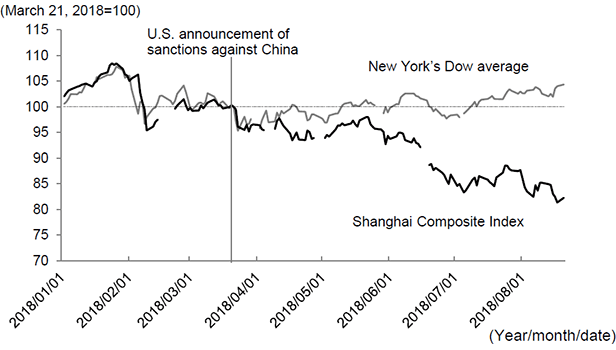
Over the same period, the yuan's exchange rate against the dollar fell by around 9%. When the yuan depreciated in the summer of 2015, the Chinese authorities conducted active dollar-selling, yuan-buying interventions in the foreign exchange market in order to support the yuan, and as a result, China's foreign currency reserves dwindled rapidly. However, this time around, China's foreign currency reserves have not decreased (Figure 2). This reflects the fact that instead of conducting exchange market interventions, China is using capital control as a means of supporting the yuan. The yuan would have dropped more steeply last time if market interventions had not been conducted. A steeper drop would also have occurred this time if capital outflow had not been prevented through capital control.
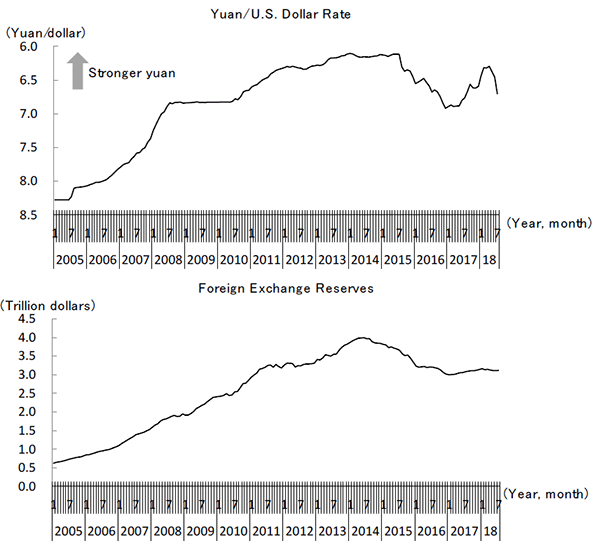
Judging from the movements of stock prices in the Chinese and U.S. markets and the yuan, we may say that China has so far been at a disadvantage in the ongoing U.S.-China trade war.
Shrinking room for economic stimulus
Amid the growing concerns over the economic slowdown, there are growing calls in China for the government to implement economic stimulus measures, but the room for doing that is considered to be limited.
First, on the fiscal policy front, following the implementation of the four trillion-yuan economic package after the Lehman Brothers collapse, debt owed by local governments increased rapidly and excess production capacity emerged at many state-owned enterprises. Although the situation is starting to improve thanks to the implementation of supply-side structural reform measures since 2016, the efforts made so far would be wasted if infrastructure investments are made on a large scale once again.
On the monetary policy front, if a monetary easing measure such as lowering the benchmark interest rate or the reserve requirement ratio is implemented, the inflationary pressure due to the import tariff hikes imposed on U.S. products will further increase. Moreover, the interest rate spread between China and other countries will widen, leading to a vicious circle of capital outflow and the yuan's depreciation aggravating each other.
Although the economic growth rate has declined, the job offers-to-seekers ratio in urban areas has hit a record high of 1.23 this year (in the first and second quarters), in contrast to 0.85 immediately after the Lehman Brothers collapse (Figure 3). This suggests that full employment has been maintained. The current economic growth rate of 6.7% is certainly low compared with the growth rate of around 10% in the past. However, given that the potential growth rate has already declined below 7% because of constraints imposed by the labor shortage, it is inappropriate to judge that the Chinese economy has entered a recession. If we also take into consideration the fact that the Chinese economy has not yet fully recovered from the negative after-effects of the four trillion-yuan economic package, the government will have to be cautious about implementing economic stimulus measures (BOX).
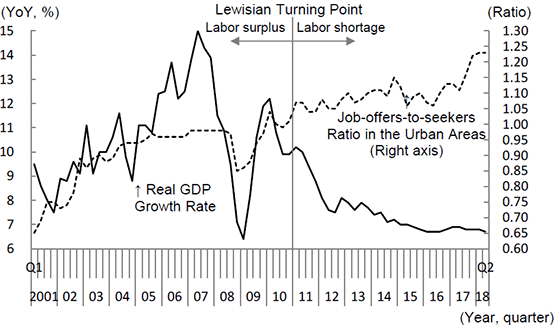
At a meeting on July 31, 2018 of the Central Committee of the Communist Party of China, it was decided to "continue to implement a proactive fiscal policy and prudent monetary policy" as a macroeconomic policy in the second half of this year (Table 2). Specifically, the statement issued after the meeting noted that fiscal policy should play a bigger role in expanding domestic demand and making structural adjustments and that money supply should be controlled so as to keep liquidity at an ample level. However, given that the growth in money supply (M2) and infrastructure investments has significantly slowed down because of the deleveraging initiative promoted by the government, the policy decided at this meeting merely represents a shift in the macroeconomic policy stance back to neutrality from austerity, rather than a plan to implement a large-scale economic package (Figure 4).
| (1) | China should maintain stable and healthy development, continue to implement a proactive fiscal policy and prudent monetary policy and make policies more forward-looking, flexible, and effective. Money supply should be appropriately controlled so as to keep liquidity at an ample level. Efforts should be made to keep employment, the financial sector, foreign trade, foreign and domestic investments, and expectations stable. |
|---|---|
| (2) | China should strengthen areas of weakness as a priority under the initiative to deepen supply-side structural reform. It should intensify efforts to complement the weaknesses of infrastructure, improve innovation capability, develop new engines of growth, eliminate institutional barriers for cutting excessive capacity, and lower the cost for companies. The strategy of rural revitalization should be well implemented. |
| (3) | China should better combine the task of forestalling and defusing financial risks with serving the real economy, stand firm on reducing the leverage ratio, ensure the proper policy intensity and tempo, and coordinate the timing of unveiling new policies. Through innovation of mechanisms, China should raise the capacity and willingness of financial institutions to serve the real economy. |
| (4) | China should press ahead with reform and opening-up and continue to study and roll out major effective reform measures. Major policies of expanding opening-up and significantly relaxing market access should be implemented, and the joint construction of the Belt and Road should be advanced in depth. Careful preparations should be made to hold the first China International Import Expo. |
| (5) | The problems in the property market should be resolved properly in determination. A differentiated approach to property market regulation of different cities should be upheld firmly to promote balanced supply and demand. The expectation should be properly guided and the market order should be regulated to firmly curb the rise in home prices. The establishment of a long-term mechanism to promote the stable and healthy development of the property market should be accelerated. |
| (6) | Efforts should be made to improve people's lives and ensure social stability. The stabilization of employment should be highlighted. Expenses on people's livelihoods, including salary, education, and social security should be ensured; poverty-relief work in abject poverty areas should be strengthened; and strenuous, meticulous efforts should be made with a deep commitment to ensure social stability. |
| Source: Compiled by the author based on "Meeting of Central Party of the Communist Party of China Held under XI Jinping's Leadership," Xinhua, July 31, 2018. | |
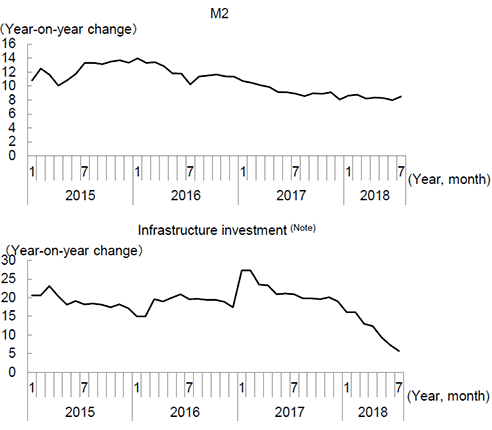
The U.S.-China trade dispute as a catalyst accelerating China's reform and opening-up
If the U.S.-China trade dispute escalates further and continues for an extended period of time, both countries are certain to suffer considerable damage, so ultimately, they must explore points of compromise through negotiation. To calm down the situation, it is essential for China to give some ground in the following points: lowering the tariff rates; strengthening the protection of intellectual property rights; easing restrictions on foreign investments; and giving the market a greater role. However, implementing such measures will greatly benefit China itself by injecting more energy into the economy. There are precedents of China using pressure from the outside as a catalyst to accelerate its reform and opening-up initiatives, such as when the country acceded to the World Trade Organization in 2001. China should not miss this opportunity to do so again.
BOX Lesson of the Four Trillion-Yuan Economic Package
The experience of the four trillion-yuan economic package that was implemented after the Lehman Brothers collapse in 2008 shows that if a country tries too hard to maintain high economic growth through expansionary fiscal and monetary policies with no regard for the fact that the potential growth rate has fallen sharply, it will have to pay a high price.
First, it was state-owned enterprises, rather than private-sector companies, that received the benefits of the four trillion-yuan economic package. A phenomenon called Guo jin min tui (state advance, private-sector retreat) that arose as a result ran counter to the reform through which China intended to give the market a greater role and led to a decline in investment efficiency.
In addition, following the implementation of the four trillion-yuan economic package, excess production capacity emerged, mainly in the steel and coal industries, and the debt load increased, mainly at state-owned companies. The experiences of many countries that had struggled with the disposal of non-performing loans, such as Japan, Thailand, and Spain, suggest that the situation of the level of private non-financial sector debt being far above the trend line is not sustainable (Figure). The International Monetary Fund (IMF) has warned that judging from the rapid expansion of the credit-to-GDP gap, which represents the difference between the debt-to-GDP ratio and the trend line, the amount of debt in China has already reached a level requiring caution (IMF, "People's Republic of China," Staff Report for the 2016 Article ⅣConsultation, July 7, 2016).
- Comparison with Japan, Thailand, and Spain -
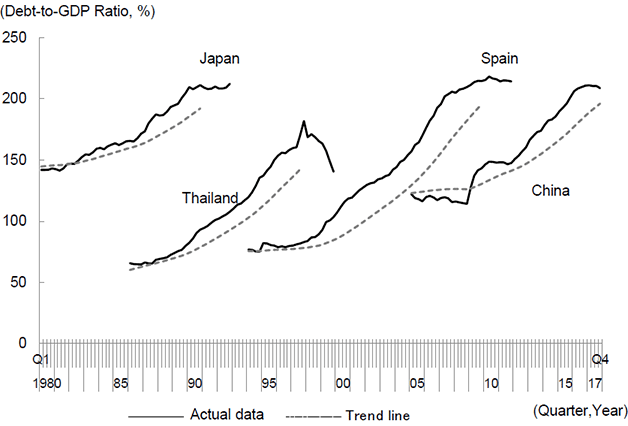
Furthermore, the swelling of the housing bubble that has been observed in recent years is attributable in large part to the aggressive monetary easing implemented after the Lehman Brothers collapse. If the housing bubble bursts, China could suffer a huge macroeconomic impact as a result of an increase in non-performing loans on banks' balance sheets, just as Japan did in the 1990s.
The original text in Japanese was posted on August 30, 2018.


